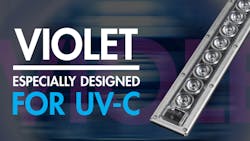Ultraviolet light is a range of wavelengths just below the visible light range. It is divided into three different bands, with UV-C starting from 200 nm and going all the way up to 280 nm. As the DNA and RNA of most bacteria and viruses are most sensitive to radiation between 260−270 nm, (germicidal effectiveness goes up to 310 nm) UV-C light is capable of killing them, acting as a contactless, chemical-free disinfectant. Although it is not always necessary to kill all pathogens, UV-C light can be used to simply prevent them from replicating. This achieves the same germicidal effectiveness at significantly lower levels of UV exposure, which is good for materials and reduces luminaire costs, etc.
Please bear in mind: UV-C is a high energy form of radiation, exposure to which is a possible health risk to humans and can also harm some materials. High dosages of UV-C can lead to serious burns, skin cancer etc. Very short UV wavelengths also produce ozone and can be considered a health risk at higher concentrations. As UV-C light is completely invisible to the human eye, it is good practice to incorporate some visible light LEDs such as blue to indicate your light source is turned on.
Why LED?
Traditionally UV-C is produced by mercury lamps that need replacing up to ten times within the lifespan of UV LEDs. Because of their longer lifetime, UV-C LEDs are a viable option compared to mercury lamps and also offer an easily controllable light source. LEDs make it is easy to optimize and adjust the required exposures and also allow the use of secondary LED optics. UV LEDs are also getting cheaper, further increasing the advantage of using them.
Why optic?
The tiny amount of light UV-C LEDs produce can be focused more effectively with the help of the right optics. This can lead to increased radiation output on the desired area and reduce the time needed for exposure while maintaining the same dosage. Using different LED clusters with compatible lenses makes luminaire power output easily scalable for different purposes.
Why LEDiL?
LEDiL was the first company to offer injection moulding optics designed and tested for UV-C, making our lenses vastly superior when compared to other silicone solutions on the market. Lenses such as VIOLET, use a special silicone grade that has a very high transmission of UV-C wavelengths and can be used for complex lens designs with easy to achieve ingress protection. Our aluminium reflectors are also highly reflective at all UV wavelengths making them especially suitable for UV-C LED clusters.






